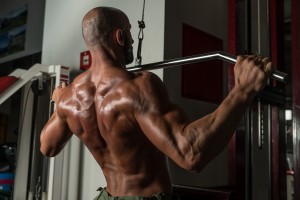The following is a book excerpt from Brian D. Johnston’s new book High Density Training: Eclectic and Strategic Bodybuilding for the Natural Athlete. I have long considered Johnston a mentor and one of the most brilliant minds in fitness for his unique ability to tie together the art and science of exercise for muscle and strength development, particularly for natural bodybuilders.

In his latest book Johnston explores the connection between training density (volume per unit of time) and it’s effect on muscle hypertrophy and achieving the bodybuilder look. This excerpt is a tongue-in-cheek look at the mistakes made by those who want to look like a bodybuilder but are unwavering in their training.
RULE 1
Become a weight lifter by trying to see how much you can lift (for whatever number of repetitions); avoid the quality of the training experience for any particular muscle since it’s the quantity of what you lift that is vital to success.
RULE 2
Force yourself to keep lifting heavier weights by increasing outlying muscle participation (squeeze the heck out of all muscles to increase overall body force); this does not increase tension on the targeted muscles, but will drain you systemically and impress your ego – and if you feel drained overall, then you must be on the right track.
RULE 3
In order to fulfill the above requirements, do not alter your program for as long as possible – stick with the same exercises performed in the same manner until you become so frustrated by looking the same, even after increasing your lifting performance by 20% or 30% (and you feel like you’re going pop an eye-ball if you add any more weight to the leg press) that eventually you have to change to another program of doing the same exercises in the same manner repeatedly (and then keep that up for as long as possible). However, during this time maintain your belief in the numbers – after all, math is a universal language that does not lie and it’s the most disciplined science we have; if the reps or how much you lift increase, then something good must be happening toward obtaining that superstar body you always wanted. As with any gambler, eventually you will win the jackpot so long as you remain consistent and keep playing those same cards.
RULE 4
Don’t even consider the idea that integrating different combinations of effort-sets-frequency-performance methods may have value and could stimulate change in muscles that are highly adaptable and have adapted to the ‘routine’ you have given them; people who think “insanity is defined as doing the same things over and over and expect a different outcome” are themselves insane and not thinking logically – eventually good things come to those who train hard (since intense effort is the key and the proverbial ‘light switch’ that allows muscle luminosity to shine down in all its glory).
RULE 5
In order to keep sets to a bare minimum, make certain your effort is 100% by the end of a set and on all sets, as this also ensures you will trigger the growth mechanism response; after all, there can’t possibly be any other factor in the overall demands of training that could contribute to triggering that cause-and-effect; it all comes down to how hard you train and if you feel like puking or passing out at the end of the set. And yes, don’t forget to add set extenders, such as forced repetitions, negatives and static holds that have you endure for another 30 or more seconds after already having reached failure…just in case reaching failure wasn’t quite enough on that particular day, or perhaps you can produce extra growth weeks or months from now from the added effort done today!

RULE 6
Avoid the pump and any deep feeling of congestion/fatigue in a muscle by keeping the number of sets you perform to a bare minimum; if you train as hard as possible and the numbers go up (in load or reps), what’s the point of performing additional sets beyond 1-2 for a muscle?
RULE 7
As you feel progressively more fatigued over the weeks, months and years, don’t forget to decrease the number of exercises performed, as well as your frequency…and to the point of barely training; at this juncture you can brag about doing 10-minute (or less) workouts every 14 days and how the massive loads you lift continue to climb (to the point of maxing out all the machines at your gym). You may want a better body, but surely the results in how much you lift someday will translate into muscle… like an alchemist turning base metal into gold.
RULE 8
As hypertrophy remains unchanged, muscles slowly flatten and body fat slowly increases (thus giving the illusion of greater size or bulk, particularly under your favorite XXL sweatshirt), mock those who do look good as their size is merely ‘edema’ and ‘inflammation’ from all that ‘pumping,’ as well as glycogen over-compensation – in other words, their look isn’t real, an illusion, whereas you are the real deal! Your results in exercise gym performance speak for themselves!
RULE 9
In support of Rule 8, make certain to keep body fat levels high so that it is impossible to determine if growth is or is not occurring; that way you can forget about it as you focus on your weight ‘lifting.’ Concurrently, avoid any picture taking with your shirt off as photographic evidence is no evidence at all – lighting can play tricks on your eyes and mind. Really, anyone who looks better than you in photos must be because of a pre-pump and trick lighting (shadows) and not because of how they train.
RULE 10
As time marches on, as you age and testosterone levels decrease, clarify to those who ask “do you weight train?” or “do you still weight train?” that you don’t have very good genetics and anyone who looks good must be on steroids – even if those people weigh the same as you at the same height, yet look so much different; if not the drugs, then it must be all that inflammation and glycogen forced into the muscles.
*****
Get the entire story on how high density training can help you optimize your muscle development and appearance. Email logicbdj@hotmail.com to order your copy of High Density Training: Eclectic and Strategic Bodybuilding for the Natural Athlete today.



